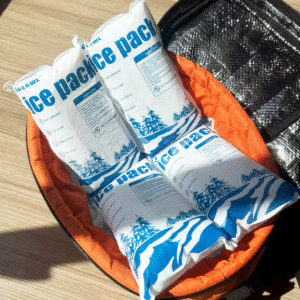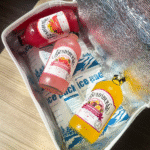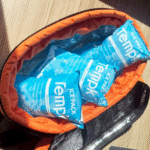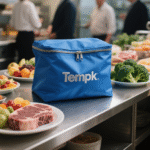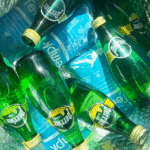If you’re learning Como usar pacotes de gelo seco, Comece com o tipo, pré -condicionamento, camadas, Embalagem apertada, e verificações de temperatura. Use gel/PCM “dry ice packs” for chill or light frozen holds, and real CO₂ dry ice for deep‑freeze lanes. Follow airline and shipping rules, and keep food at or below 40°F (4°C) for safety. You’ll find everything you need here—simple, tested, and ready to use.
-
Choosing refrigerants: When gel/PCM beats CO₂, and where each shines for long‑distance cold chain.
-
Sizing and runtime: A quick estimator to right‑size packs for route time and load mass.
-
Como embalar: Step‑by‑step “layer and separate” method to avoid cold damage and extend hold time.
-
Rules and safety: 2025 TSA gel‑pack screening and FAA dry ice limits explained in plain English.
-
Real‑world playbooks: Mais frio, parcela, and flight scenarios you can copy today.
How to use dry ice packs vs. gel/PCM—what’s the difference?
Resposta curta: Most “dry ice packs” you buy are sealed gel or PCM packs, not solid CO₂. Gel/PCM packs hold a set temperature (for chill or soft‑frozen), são reutilizáveis, and need no venting. True dry ice (Co₂) sits at −78.5 °C/−109 °F, requires vented packaging and airline approval, and is best for deep‑freeze. Use gel/PCM for 2–8 °C holds; choose −15 °C PCMs or CO₂ for frozen lanes.
Por que isso importa: You protect your product by matching the melt/freeze point to your target zone. Choose 0–5 °C gels for produce and meds, −15 °C PCMs for “freezer‑like” holds without CO₂, and CO₂ only for ultra‑cold or long, rotas quentes. That’s the simplest way to master how to use dry ice packs.
How to use dry ice packs for 2–8 °C or frozen lanes
Pick the refrigerant that melts near your setpoint. PCMs flatten temperature swings while they phase‑change, so your goods avoid spikes. Precondition correctly (8–12 h for 0 °C gels; 24–36 h for −15 °C panels) and add thin barriers between packs and delicate foods to prevent “ice burn.” This is the practical backbone of how to use dry ice packs without damaging contents.
| Opção de resfriamento | Freeze/melt point | Manuseio & regras | O que isso significa para você |
|---|---|---|---|
| Standard gel “dry ice pack” | ~ 0 ° C. / 32 ° f | Sem Hazmat; no vent needed | Ideal for 2–8 °C. Gentle on produce/biologics. |
| PCM freezer pack | −15 °C / 5 ° f | Sem Hazmat; long pre‑freeze | “Freezer‑like” holds without CO₂. |
| True dry ice (Co₂) | -78,5 ° C. / −109 °F | Embalagem ventilada; airline approval | Deep‑freeze and long lanes; gloves and labeling required. |
Dicas práticas que você pode usar hoje
-
Separate & camada: Place a thin cardboard or rack between packs and fragile items.
-
Cercar a carga útil: Sides + top in parcels; fundo + top for frozen coolers.
-
Preencher vazios: Towels or dunnage defeat warm air gaps and extend runtime.
Caso em breve: A pastry shipper used two −15 °C PCMs on sidewalls and two 0 °C gels on top in a 12 L EPS. Depois 30 hours and several hand‑offs, center mass stayed below 10 °F, and fruit toppings showed no frostbite.
How to use dry ice packs step‑by‑step for shipping?
Core sequence: Precondition → Layer → Separate → Pack tight → Vent (Somente CO₂) → Monitor. That order maximizes hold time and product quality. For gel/PCM “dry ice packs,” venting is not required; para co₂, it is mandatory. Use a thermometer—don’t guess.
Detailed walkthrough: Confirm pack type; prefreeze to the spec point; add separators; cercar a carga útil; preencher vazios; place a thermometer; and if using CO₂, use luvas, etiqueta UN1845, and allow gas to escape. This disciplined routine is the safest way to practice how to use dry ice packs at scale.
Packout estimator (cópia -pasta)
Estimate the number of 1 kg gel/PCM packs for 2–8 °C holds:
-
ConditionsFactor: 0.8 (cold/shade), 1.0 (normal), 1.2–1.4 (hot/sunny, frequent opening)
-
A 1 kg 0 °C gel yields ~one day for ~2 kg payload in a decent shipper; adjust for heat and access.
| Preconditioning guide | Typical point | Prep time | O que isso significa para você |
|---|---|---|---|
| Standard gel pack | 0 ° c / 32 ° f | 8–12 h | Best for 2–8 °C; faster turnaround. |
| PCM freezer panel | −15 °C / 5 ° f | 24–36h | Longer runtime; freezer‑like without CO₂. |
| True dry ice (Co₂) | -78,5 ° C. | Buy same day | Deep‑freeze only; always vent packaging. |
Field‑tested packing moves
-
For chilled food: Bottom layer of 0 °C gels, carga útil, one gel on top; keep shaded.
-
For frozen goods: −15 °C panels on sides + principal; prefreeze contents; add a gel buffer near delicate items.
-
Para cargas mistas: Use CO₂ near the deep‑freeze zone and gels/PCMs as buffers near sensitive items; vent outer box.
How to use dry ice packs for flights without hassles?
TSA (gel/pcm): You may carry gel or freezer packs if they’re frozen solid at screening; medically necessary packs can be slushy—declare them.
FAA (Co₂): Max 2.5 kg (5.5 Libra) per passenger/package; Aprovação do operador; embalagem ventilada; proper “Dry ice/Carbon dioxide, solid” marking with net quantity. Build your travel plan around these two rules, and you’ll know exactly how to use dry ice packs on flight days.
Carry‑on checklist
-
Freeze packs solid and place at the bottom of your cooler bag.
-
Expect secondary screening if any pack is slushy; mention medical needs early.
-
Leave vent paths for CO₂ and label perishables clearly for agents.
How to use dry ice packs in coolers for camping and day trips?
For drinks and dairy (2–8 ° C.), line the bottom with 0 °C gels, add food, and top with one gel. For frozen meat or fish, run −15 °C panels along the sides and top, and keep a small 0 °C gel between frozen and “chill‑only” items. Limit lid openings, keep a small “day‑use” cooler, and wrap the main cooler if you must store it in direct sun.
2025 cold‑chain updates and trends
O que há de novo: Reusable PCM systems and curbside‑recyclable liners are expanding fast, as teams cut waste without sacrificing hold time. More lanes pair PCMs with condition monitoring for fewer excursions. The upshot for how to use dry ice packs: smarter hybrids, melhor isolamento, and clearer audit trails.
Último em um olhar
-
Reusable PCM shippers: Growing steadily; reduce consumables and total cost per ship.
-
Fiber‑based liners: More curbside‑friendly designs with solid thermal performance.
-
Mainstream IoT monitoring: Temperature loggers now standard on critical lanes.
Insight de mercado: Expect continued 5–9% CAGR in cold‑chain packaging segments through the late 2020s, led by life sciences and e‑grocery. Design for reuse flows and PCM availability when you standardize how to use dry ice packs across networks.
Perguntas frequentes: Como usar pacotes de gelo seco
How much should I use for 24–72 h routes?
Plan ~5–10 lb per 24 h for small parcels with good insulation; add buffer for heat or delays. Test on your route before scaling.
Are “dry ice packs” real dry ice?
Geralmente não. Most are gel/PCM packs marketed as “dry ice packs.” Real dry ice is solid CO₂ and far colder. Check the spec sheet.
Do gel/PCM packs need venting?
Não. Venting is only for CO₂ dry ice because it releases gas as it warms.
Is food safe with packs touching it?
Use a thin barrier (towel/cardboard). Keep chilled food ≤40 °F (4 ° c) and confirm with a thermometer.
Can I bring packs through TSA?
Sim, if frozen solid at screening; medically necessary packs may be slushy—declare them.
Resumo & PRÓXIMOS PASSOS
Pontos -chave: Confirm gel/PCM vs CO₂, precondition to spec, layer with separators, pack tight, and monitor temperatures. Follow TSA gel‑pack rules and FAA dry‑ice limits, and keep food ≤40 °F (4 ° c). That’s the reliable way to master how to use dry ice packs.
Your action plan:
-
Define the hold zone (2–8 ° C., −15 °C, or deep‑freeze).
-
Choose packs: 0–5 °C gels for chill; −15 °C PCMs for freezer‑like; CO₂ para ultrafrio.
-
Use the estimator to size mass and run a pilot with a logger.
-
Standardize a packout SOP and train teams. Precisar de ajuda? Book a free consult with Tempk’s cold‑chain team.
Sobre Tempk
We help teams design packout playbooks and data‑driven calculators for perishable food, biopharma, e produtos especiais. Our guidance reflects current TSA/FAA/PHMSA rules and modern PCM options, so your shipments stay compliant, predictable, e custo-benefício. We test in real routes and publish brand‑agnostic templates your team can use immediately.
Chamado à ação: Talk to a Tempk cold‑chain specialist — book a free consultation.






